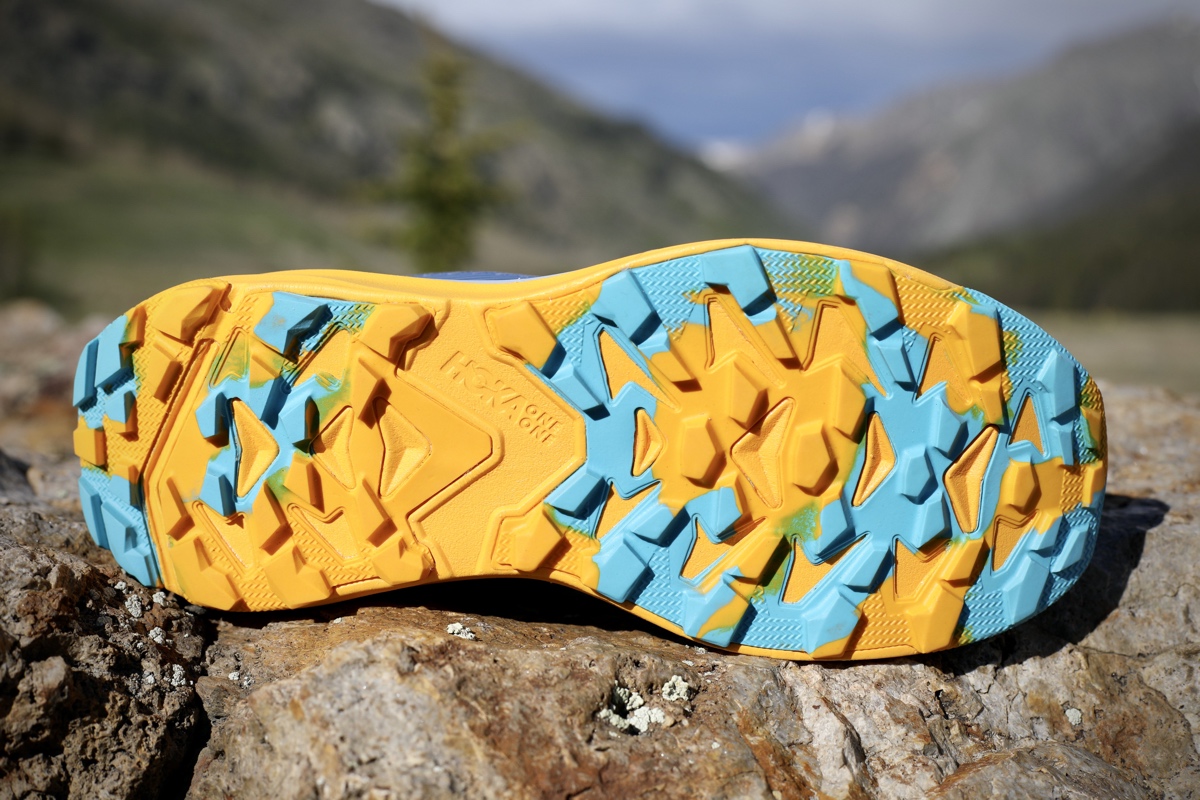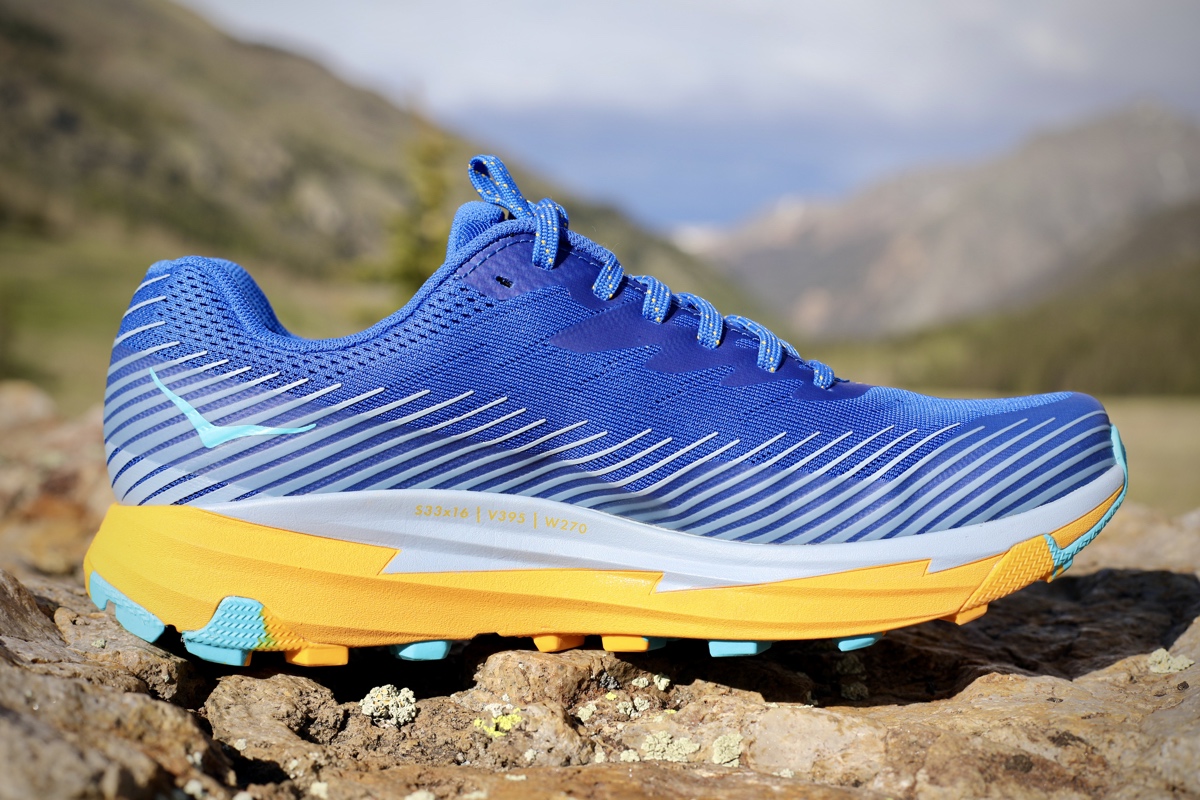For the latest on the Torrent family, read our full Hoka Torrent 4 review.
Our Favorite Trail Running Shoes
Check out our Best Trail Running Shoes buyer’s guide to learn about our current favorite trail running shoes!
Hoka Torrent 2 Review
The Hoka Torrent 2 ($120) is the company’s attempt at a lightweight, lower-cushioning trail running and racing shoe. Our tester, however, found the Torrent 2 to do much more than fast running and racing. While it might not be the right shoe for very long days on aggressive terrain, we found the Torrent 2 to be pretty close to a do-it-all shoe for runners seeking something more pared down than the rest of the Hoka trail running shoe lineup. Learn more about the Torrent 2 in this video review.
We’ve named the Hoka Torrent 2 one of the best trail running shoes!
Shop the Men's Hoka Torrent 2Shop the Women's Hoka Torrent 2
Hoka Torrent 2 Review Transcript
Hey, welcome to Trail Trials, the video-review section of iRunFar. My name is Travis Liles and in this video, we’re looking at the Hoka Torrent 2.
Let’s start off by digging into the specifications. The Torrent 2 comes in at a 5-millimeter drop from heel to toe. It weighs 9.1 ounces, even though they advertise it as 9.3 ounces in a men’s size 9. It is supposed to be the lightweight and nimble—or probably in terms of Hoka, their most minimalist trail shoe. With all of that information, let’s take a look at this shoe and all its components and see what it’s all about.
Hoka Torrent 2 Outsole
Let’s look at the Hoka Torrent 2 outsole. You can a see lot going on, cool patterns on the bottom. Let’s draw your attention to the yellow and black, which is the outsole itself. You’ve got some pretty deep lugs on this shoe, especially because this is meant to be a faster shoe. I think these are really solid lugs. You have forward-facing lugs in the front and rear-facing lugs in the back to aid in traction going uphill and downhill.
They use a slightly sticky rubber compound on here, which works well in a lot of conditions. It feels good when you’re going across something kind of slick, like a wet bridge. I feel like there’s enough traction on this, that it’s not an unsafe type of shoe. I have some trail shoes that are definitely harder rubber, and they have a tendency to almost slide across something like that. This is a nice in-between, where there’s enough traction via the lugs and the rubber type’s friction that it’s going to provide a bit more grip.
You can see there are a lot of weight savings here. All of this orange [sticking out between the yellow and black outsole] on the bottom is the midsole. The midsole is exposed in a lot of places. The downside to that is some of these things [pointing to an outsole lug that’s broken] wear. Rather than being a full piece of rubber that’s laminated to the midsole, the midsole is carved out and then [pieces of] tread are glued down into those carved-out holes. Overall it works pretty well, but you can see this lug’s out on the side and it’s out on the corner, and it doesn’t take much downhill on aggressive terrain for them to break.
Hoka Torrent 2 Midsole
Because there’s no rock plate in the midsole, you get ground feel in this shoe. Speaking of midsole, let’s cross over into the Hoka Torrent 2’s midsole. Most of us trail runners know that Hoka’s thing is maximal stack height. But this is a much lower stack height. In fact, this falls into what I would call minimal for a Hoka. You can see a much thinner midsole in general.
This is a neutral midsole. There is no pronation control, there’s no type of cage that diverts your foot to do anything specific. There are no stability mechanisms.
This shoe uses the PROFLY foam, which is the same foam used in the Carbon X, their fast road racing shoe. So this shoe is aimed at the responsive side versus the stability side, or even versus the plush side of the Hoka line. This falls into being light and nimble. It even says it on their sock liner. I think that this shoe actually accomplishes that fairly well.
A couple other points here, you see some statistics written on the midsole. One of those is “S33x16,” which is the spring of the shoe. Basically, there’s a rocker in this. If you’re a Hoka fan, then you know they like rockers and this shoe has that. You really get a view of it here [looking at the shoe from the side]. That 33 and 16 are the heights of the toe and heel off the ground, respectively. It’s not as aggressive of a rocker as some shoes from Hoka, but definitely it’s got that rocker feel.
The “V395” statistic on the midsole, that’s the shoe’s volume in centimeters. Even though it’s a lightweight-feeling and nimble-feeling shoe, it’s fairly wide and has a lot of area for my foot to expand and not feel like it’s cramped in there. This is generally not the case for a lightweight or faster-feeling shoe.
When you look down at this shoe from the top, you can see that the outsole flares out [around the toebox] and on the heel. If you look at the bottom of the shoe, it’s as wide as Hoka’s maximal-cushion shoes. You’ve got a stability type of platform, but they’re doing it with this fast foam and without putting any mechanical things in the shoe that change your gait. It’s just providing a wide landing zone so you’ve got more comfort. You’ve got more ability for your toes to wiggle and maybe for your foot to swell. But they do that in a way that still feels like you can get some turnover with this PROFLY foam.
Hoka Torrent 2 Upper
Moving up to the Hoka Torrent 2 upper: here is a very simple upper. Just like the midsole is no nonsense, the upper is a lot of that no nonsense too. It’s a fully mesh upper with bonded overlays so there’s no additional stitching, which again keeps the weight down. You can run your hand inside the shoe, there are no seams to add rubbing points on your foot. It’s just this thermoplastic polyurethane (TPU) overlay all the way around the shoe. It starts at the heel and runs all the way to the toe, along the side, and around the back. Additionally, there’s some reinforcement points on that TPU again at the laces. Instead of adding metal eyelets or something along those lines, they’ve added this TPU which is lighter weight, keeping that more minimal feel to this shoe. The only thing I would say on this rand is that even though it is lightweight, it doesn’t drain super well because there’s really nowhere for water to get out.
I am very impressed with the fact that it’s able to lock my foot in with really not much happening in the upper. There are no overlays or anything creating that cradle-like feel that you see in a lot of other trail running shoes and some that I’ve reviewed here in the recent past. What you see is what you get. There’s nothing sandwiched in between the outside and inside to add stability. They did a nice job of keeping this shoe in a really good middle ground where it’s wide enough to let your foot feel relaxed, but it also has a locked-in feel where you can run downhill for a long time and not worry about your foot moving all over the place.
From a toe-bumper standpoint, it’s pretty lightweight. Again, this shoe is not about protection. It has just enough of everything that it allows it to work well on the trail. But in the most rugged of conditions, this shoe is generally not aiming toward that and you can tell that by the materials on the upper, the outsole, and the way that it’s constructed.
The last two things that I’ll point out are in the heel cup. You do have a structured heel cup. If you look at this TPU overlay that’s orange on the shoe, that’s really where the structured portion of the heel cup starts and stops. Then at the top where there’s the notch for the Achilles is where it has a little flexibility. There is medium padding around the heel cup, which again does a nice job of locking your foot in.
Lastly, you have a somewhat gusseted tongue that starts at the third eyelet and goes down to the very bottom cross lays. This keeps the tongue from falling from side to side, keeps it centered. It is a well-padded tongue, which is awesome. I guess Hoka figured they saved enough weight on this shoe overall that they didn’t have to [make the tongue as thin as what some other companies are doing]. You have a tongue that is padded that allows you to cinch the laces down if you need to, or just add some volume and add some comfort into the top of your foot, especially if you’re wearing this shoe for a while.
Hoka Torrent 2 Overall Impressions
In closing, if you watch my reviews, you see that I gravitate toward do-it-all shoes. I would put the Hoka Torrent 2 in that conversation. It’s a shoe that I don’t have to think about what terrain I’m going to get on, what I’m going to do. Am I going to be on a treadmill, on gravel, or concrete, or road, or something really aggressive and rugged, or a buffed-out trail? This shoe does well across all of those things.
Where you want to think about this shoe and really aggressive terrain is for how long you’re going to be on it. Because this outsole and the lack of a full-length rubber tread, and just this exposure at the bottom, it adds to foot fatigue. All these outsole cutouts are awesome because the shoe comes in at a low 9 ounces in a men’s size 9. But this means that rocks and thorns can poke through.
And because it’s not a maximalist cushion like other Hokas that don’t have rock plates, you don’t have that extra layer of protection. I’ve had moments where I’ve stepped on something and it feels like it’s poking me in my heel. This is in comparison to a Hoka Speedgoat, or something with a rock plate where a lot of that pressure gets deflected throughout the midsole. The weight savings here, awesome. You’re giving up protection for lightness.
So this shoe, where does it fit in? If you’re doing that faster run, if you want an additional shoe to add to the stable, if you like the feel of Hoka cushioning but you don’t want a big stack height, if you don’t have a tendency to run on really aggressive, sharp, rocky types of terrain all the time, this shoe works. It even works on that terrain, but it’s just over time I feel that terrain.
What would I like to see? I’d love to see a thin rock plate in here and for them to shore up this bottom package with a full-length rubber tread. It would save some of this shearing and add protection. Then you’d have a shoe where you don’t have to worry about it wearing down, shearing lugs, and foot fatigue on aggressive terrain. That said, if you’re somebody that doesn’t have a sensitive foot, if you’re somebody that’s looking to get into Hokas, if you’re somebody that doesn’t mind a lack of protection for ground feel, you can do a lot in this shoe. I have done a lot in this shoe and a second pair of Torrent 2s after the first met their end of life.
It’s a shoe I like, I reached for it. It does a lot really well. It’s really only when you extend into those really long distances or extremely rugged terrain that you might want to ask yourself if there is enough protection here.
Shop the Men's Hoka Torrent 2Shop the Women's Hoka Torrent 2
Call for Comments
Questions, comments, or feedback on the Hoka Torrent 2? What are your feelings of it? Do you feel like it has enough protection? Is it an approachable shoe from Hoka if you haven’t loved their big stack heights or the aesthetics weren’t for you? Leave comments like those and others below. Thanks for watching, we’ll catch you next time.
[Editor’s Note: If you’re affiliated (i.e., an employee, ambassador, etc.) with a brand, please share your relation in each of your comments on this article. Thanks!]
Our Favorite Trail Running Shoes
Check out our Best Trail Running Shoes article to learn about our current favorite trail running shoes!





